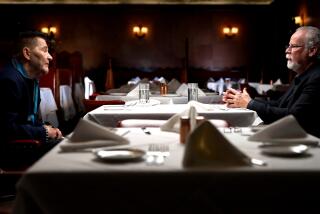THE KILLING SEASON: A Summer Inside an LAPD Homicide Division.<i> By Miles Corwin</i> .<i> Simon & Schuster: 336 pp., $23</i>
- Share via
Imagine a buddy movie, part Nick and Nora, part “Lethal Weapon.” A veteran homicide detective, parents Lithuanian-born, Venezuelan boyhood, perfect Spanish speaker, male, white, teams up with rookie homicide detective, female, black, to investigate killings in her home turf, South-Central Los Angeles. No romance, they’re partners.
He favors Western boots, chews and spits tobacco, looks like a grizzled cowhand. Has been working South-Central for 15 years. Hopes to maintain a third marriage despite middle-of-night homicide calls. Huge backlog of cases, always under pressure, always behind, hates paperwork, can’t use computer. Is shrewdest, sharpest-eyed crime scene investigator in South-Central. Near burnout, never succumbs. Favors shapeless gray and blue suits, $5 ties. Doesn’t wash hands before lunch after handling dead body. (She balks. Won’t eat with him until he washes.) Also a hunter. Dreams of, lives for, annual fall trip to Wyoming--at the end of the killing season. During those weeks bathes but once.
“It must be a guy’s thing,” she says of the joy he takes stalking and shooting deer, camping in the woods, not bathing. She wears silk stockings, designer jackets, skirts, slacks, boots. Fastidious, great at paperwork, computer. But is no polite secretary or sugary pushover. Tall, strong. Won Police Olympics women’s power-lifting championship. Decked a wise-guy gangbanger, broke his nose. Fixes a large drawing of black cat on her desk. Underneath, a sign in big block letters: “I HAVE PMS AND A 9-MILLIMETER HANDGUN WITH 16 ROUNDS. ANY QUESTIONS?”
“The Killing Season” is indeed a grab-you-by-the throat page turner, but it’s also a serious book for those who want to comprehend the disheartening dilemmas contemporary inner-city crime poses for law enforcement and the rest of us. I took notes on practically every page.
Pete Razanskas and Marcella Winn are the main detectives Miles Corwin shadowed for his reportage on a summer spent with the LAPD’s South-Central Homicide Division.
Detectives assigned to that division investigate ever more violent and impersonal inner-city murders. Homicide patterns (according to a 1993 FBI study) have shifted dramatically. In the past, most were committed by a spouse, a family member, a friend, an acquaintance. Domestic cases, “Ma and Pa Kettle” killings, are most easily cleared by the police. By the early 1990s, for the first time, more than half the nation’s homicides were committed by strangers or unknown persons.
The South-Central killings investigated by Razanskas and Winn were mostly of that kind: drug-related hits, drive-by shootings, homicides committed during a robbery, bodies dumped away from the place of death. Crimes that used to be simple robberies or car thefts end up as “senseless” killing. The more “senseless” a killing, that is, the less rational the link between motive and the killing of a compliant victim, the harder it is to solve.
Such crimes produce slight physical evidence. Eyewitnesses often fear retaliation against themselves or their relatives by the killer or his gang cohorts. Gangbangers who expect future imprisonment fear a “snitch jacket” and refuse to identify killers. Consequently, South-Central deaths are among the most difficult for detectives to “close,” that is, to produce enough acceptable courtroom evidence for the district attorney to prosecute.
Because the detectives Corwin followed are so hard-working and professional, “The Killing Season” is the best advertisement the LAPD has had in a long time. Former LAPD Chief William Parker (Daryl Gates’ mentor) told an interviewer in 1962 that the television program “Dragnet” was “one of the great instruments to give the people of the United States a picture of the policeman as he really is.” Well, it wasn’t. The videotaped beating of Rodney King shattered the “Dragnet” image of the LAPD. Whatever shards of the icon remained were crushed by the perjured testimony of Mark Fuhrman and the mistakes of the LAPD crime lab in the O.J. Simpson case.
Miles Corwin’s intelligent, empathetic and in-depth observations, conducted from March to October 1993, offer rare insights into real and dedicated police who undertake a tough, grinding assignment. They are neither unfailingly polite nor mistake-free. Whatever their imperfections and transgressions, they are on the whole admirable. Their work is so demanding and psychologically draining, I found myself wondering how they manage it.
Razanskas, who lives in a zone of interrupted sleep and bodies, does it by maintaining a sense of humor. He is a relentless kidder. When a new coroner’s investigator arrives at a killing scene, Razanskas takes him aside and tells him he’s not supposed to be there, that there’s a new policy. “Didn’t anyone tell you?” he asks.
The coroner’s man shakes his head.
“You don’t have to come to the scenes anymore. We just toss the bodies in our trunk and we bring ‘em to you.” The investigator finally gets the joke.
Razanskas and Winn can also be crabby and difficult, exhausted by middle-of-the-night calls. On an ordinary day, Razanskas awakens at 4:30 a.m. to commute to the office by 6 a.m. Since homicides can happen any time when they are on call, the phone often rings at 2 or 3 in the morning, disturbing the few hours allotted to sleep. As for fun, entertainment and family life, these take second position.
These two cops know the law and test its limits. Sometimes, to gain incriminating admissions, they bully suspects a bit; sometimes, they trick them. The law allows police to lie to suspects about evidence. The law allows them, for example, to tell a suspected killer, who has agreed to talk, that his crime partner has confessed even when that’s a lie. (One also has to wonder whether such permission to lie during interrogation justifies perjury--for similar “ends justifies the means” reasoning--in the minds of some cops.)
They are determined to apprehend those who they suspect committed homicide, and they know their job. Razanskas especially is ingenious at reconstructing a death scene. “The untrained eye sees just a battered and bloody body, and the hows and whys and the whens are impossible to determine,” Corwin writes. “But Razanskas sees a tableau of action and reaction. A homicide scenario. He sees how the disparate elements--the fibers, the wounds, the body position, the ligature marks--conjoin to create a pattern.” Razanskas and Winn are also energized by their emotions. Investigating homicides in a zone of danger not of their making, they despise the killers and empathize with most victims and their families.
South-Central police are being shot at more than ever, partly because firearms are so readily available and because of the residue of friction between the LAPD and South-Central residents. And some cops say that California’s “Three Strikes” initiative motivates suspects with two priors to shoot it out with police rather than face a 25-to-life sentence.
Razanskas remains in his draining South-Central assignment out of an ego fueled by professionalism; South-Central is the biggest challenge a homicide detective can face.
Winn works there because she hates what the gangbangers are doing to her community. She is incensed when a teenage gangbanger robs a hard-working, 24-year-old man of $10 in front of his child, then coldbloodedly kills him. “A man getting shot in front of his little boy pisses me off,” Winn says. “I’m motivated on this one. I don’t care what it takes. I want the little bastard who did this off the streets.”
The LAPD’s reputation for racism has been well-documented. But the South-Central Division homicide detectives are themselves multiethnic and work in a place where both killers and the dead are usually African American and Latino. The detectives make moral judgments around such issues as the brutality of the assault, its rationality and the social worthiness of the victims. They feel different about an 80-year-old woman who is robbed, beaten and killed than about a gangbanger who is shot protecting his crack house against the predations of a rival.
Corwin, who was a crime reporter for the Los Angeles Times, says he was moved to write the book when he spent a single night in South-Central following a detective around to learn about the changing nature of homicide in the city. He was astonished and appalled by the three killings he learned about, all within three hours, within one square mile. And he was impressed by the willingness of South-Central relatives, usually ignored by the press, to talk to a reporter.
He maintains that although there is a great clamor about the media’s overemphasis on crime news, South-Central’s crime is underreported and that it’s always been that way. As a result, crimes against the poor and people of color receive less attention from the public and the police than is warranted.
Still, one has to question how much difference more pressure will make. Much as I found the detectives to be admirable human beings, the victims and their families compelling and Corwin’s reportage laced with verisimilitude, I also found myself depressed at the futility of the work of the detectives. Most of the killers are kids who never had much of a chance in life, and they will surely be replaced by others, even when apprehended, prosecuted and punished. Unless the police and the rest of us do something about preventing crime in South-Central and communities like it, every summer will bring more young criminals, more homicides, more victims, more arrests and convictions--and more killing seasons.
More to Read
Sign up for our Book Club newsletter
Get the latest news, events and more from the Los Angeles Times Book Club, and help us get L.A. reading and talking.
You may occasionally receive promotional content from the Los Angeles Times.







